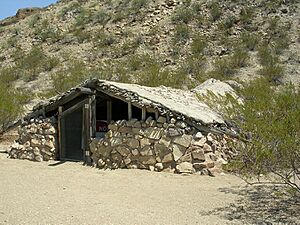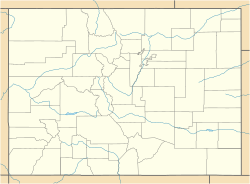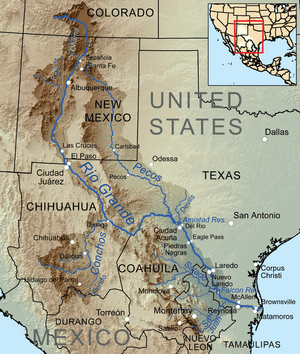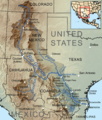Trinchera Cave Archeological District facts for kids
Quick facts for kids |
|
|
Trinchera Cave Archeological District
|
|
| Location | Along Trinchera Creek, 8.5 miles (13.7 km) north of Trinchera |
|---|---|
| Nearest city | Trinchera |
| Area | 460 acres (190 ha) |
| Architectural style | Stacked stone enclosure |
| NRHP reference No. | 01001120 |
| Added to NRHP | October 22, 2001 |
The Trinchera Cave Archeological District is a special place in Las Animas County, Colorado. It's an archaeological site where experts have found many old items. These items mostly date from 1000 BC to AD 1749. Some even older items from the Archaic period were also found.
This important site was added to the National Register of Historic Places in 2001. It is located on land managed by the state.
Contents
Where is Trinchera Cave Located?
Trinchera Cave is found in the Trinchera Creek canyon. This area is in south central Colorado, east of Interstate 25. The land here changes a lot. It has different climates and types of land.
The height of the land ranges from about 5,370 feet (1,637 meters) to 14,345 feet (4,372 meters). The lowest parts are rolling hills and valleys. The highest parts are steep mountains and cliffs. Lower areas get less than 6 inches (15 cm) of rain each year. Mountain areas get 20 inches (51 cm) or more, mostly as snow. This area is home to animals like elk and deer.
Who Lived at Trinchera Cave?
Archaeological findings show that people lived or camped at Trinchera Cave for a very long time. This includes groups from the late Archaic period, the Sopris Phase, the Apishapa culture, and later prehistoric times. People were here from thousands of years BC up to AD 1749.
Early People: The Archaic Period (5850-3050 BC)
People during the Archaic period were hunter-gatherers. They hunted smaller animals like deer, antelope, and rabbits. They also gathered wild plants for food. These groups moved around with the seasons. They went to different places to hunt and gather.
Later in the Archaic period, around AD 200-500, people started eating corn. They also began making pottery. Pottery was useful for storing and cooking food.
Experts found large, pointed tools from the Archaic age at the site. These tools are similar to ones found in Texas and near Denver. Finding these tools might mean there was a connection to the Basketmaker culture. This culture lived in New Mexico and Arizona. Trinchera Cave is one of 17 such sites in southern Colorado.
Sopris Phase: A Hunter-Gatherer Culture (AD 1000-1250)
The Sopris Phase was a culture of hunter-gatherers. They lived in the Upper Rio Grande area after the Archaic period. They were influenced by Pueblo people, like those at the Taos Pueblo. They also traded with people in the Upper Rio Grande.
Archaeologists found two types of pottery at the cave: Santa Fe black-on-white and Taos gray. These were in the second oldest layer of the rock shelter. More pointed tools were also found in this layer. Research shows these items date from AD 1100 to 1350, likely in the 1200s. This shows they traded with people from the American Southwest.

Panhandle Culture and Apishapa Phase (AD 1200-1400)
The Panhandle culture was a prehistoric group. They lived on the southern High Plains between AD 1200 and 1400. Most of their sites are in the panhandle areas of Oklahoma and Texas.
Key features of the Panhandle culture include:
- They were very similar to other groups on the Central Plains.
- They had some, but less, trade or influence from Southwestern Pueblo cultures.
- They built stone structures with one or many rooms.
Just above the Sopris level at Trinchera Cave, experts found parts of a Jacal structure. A jacal is a type of hut made from poles and mud. This level seems to show influence from the Panhandle culture. This is because of items found there, like certain types of pottery.
The Apishapa Phase lasted from AD 1000 to 1400. One archaeologist, Robert G. Campbell, believed it grew from the Panhandle culture. Apishapa people sometimes lived in stone or slab buildings. They made pottery with cord marks and used smaller pointed tools. Unlike other Plains tribes, they did not use tools made from bison bones. They were mostly hunter-gatherers, but sometimes they farmed.
Apishapa people lived in rock shelters, stone structures, or campsites. These were usually in safe areas near flowing water in northern New Mexico or southern Colorado. Items from this phase include many tools, cord-marked pottery, and baskets.
How Was Trinchera Cave Discovered?
William Louden, who was a historian, geologist, and rancher, found the cave. He saw it from an airplane in 1947. He and Ruth Henritze then dug for old items. They both wrote books about archaeology.
In 1984, a museum was named after them. It is the Louden-Henritze Archeology Museum. It is at the Trinidad State Junior College.
What Did Archaeologists Find?
The Cave Itself
The cave is about 30 by 8 meters (98 by 26 feet) under an 8-meter (26-foot) overhang. It is surrounded by sandstone. The floor is made of shale. Inside the rock shelter, there were once walls made of sandstone blocks. These walls were thought to be about 1.5 meters (5 feet) thick. A creek runs next to the shelter.
The cave stays cool in the summer because of the overhang. In the winter, the sun warms it up.
Items Found and Connections to Other Sites
Trinchera Cave is similar to other archaeological sites in eastern Colorado. These include Franktown Cave and Chamber Cave. All three sites show that people lived there for a long time. They also found many items that usually don't last, like things made from plants.
Trinchera and Chamber Cave are in the Arkansas River basin. They are linked to people from the southern plains. Franktown Cave is near Denver. The last people to live in Trinchera Cave were the Apache and Comanche tribes.
Archaeologists dug at the cave between the 1950s and 1970s. They found many items that don't usually last, just like at Franktown Cave. These items were stored at Trinidad State Junior College. However, information about these items has not yet been fully written down and shared.
Studies and Excavations at the Cave
| Date | Who Studied It? | What Did They Do? |
|---|---|---|
| 1954–1957 | Hal Chase and Herb Dick, professors | They dug at the site. |
| 1974 | Carol Simpson | She studied the site for her master's degree. |
| 1997–1999 | PAAC volunteers | Volunteers surveyed the Trinchera Creek canyon. They found 57 sites and 18 single items. Most items were from after AD 1500. They found tools made from stone and pottery. These items were similar to those used by southern plains people. |
| 1999 | Michael Nowak and students | They dug at the site to record and date items using radiocarbon dating. |
| By 2003 | Possibly Smithsonian Institution | They used special surveys (like magnetic and seismic) to find the walls of an old "jacal" structure. These walls were reported in 1974 but later covered up. |
| 2018-2019 | Ryan Baker | He studied how stone tools were used by hunter-gatherers. His work helps us understand how ancient people lived and used the land. |
Louden-Henritze Museum of Archaeology
The Louden-Henritze Museum of Archaeology is in Trinidad, Colorado. It's on the campus of the Trinidad State Junior College. The museum has a copy of the Trinchera Cave rock shelter. It shows examples of items made by ancient people. These include pottery, arrowheads, and items made from plants. You can see braided ropes, grass mats, and sandals made from yucca plants. The dry, protected cave helped keep these plant items safe for a very long time.
Images for kids
-
Example of a jacal structure, Big Bend National Park, Texas






